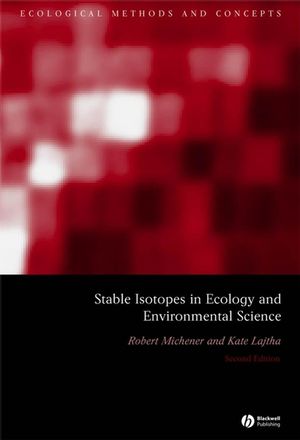Stable Isotopes in Ecology and Environmental Science, 2nd EditionISBN: 978-1-4051-2680-9
Paperback
594 pages
October 2007, Wiley-Blackwell
 This is a Print-on-Demand title. It will be printed specifically to fill your order. Please allow an additional 10-15 days delivery time. The book is not returnable.
|
||||||
Contributors, x
Abbreviations, xiii
Introduction, xvii
1 Stable isotope chemistry and measurement: a primer,
1
Elizabeth W. Sulzman
Introduction, 1
What isotopes are, what makes them distinct, 1
Properties of ecologically useful stable isotopes, 11
Technological advances and current trends in the ecological use of isotopes, 14
Acknowledgments, 18
References, 18
2 Sources of variation in the stable isotopic composition of
plants, 22
John D. Marshall, J. Renée Brooks, and Kate Lajtha
Introduction, 22
Carbon isotopes, 22
Nitrogen isotopes, 35
Hydrogen and oxygen isotopes, 39
Conclusions, 49
References, 50
3 Natural 15N- and 13C-abundance as
indicators of forest nitrogen status and soil carbon dynamics,
61
Charles T. Garten, Jr, Paul J. Hanson, Donald E. Todd, Jr,
Bonnie B. Lu, and Deanne J. Brice
Introduction, 61
Significance of 15N-abundance to soil carbon sequestration, 63
Vertical changes in soil 13C-abundance and soil carbon dynamics, 69
Conclusions, 77
Acknowledgments, 77
References, 77
4 Soil nitrogen isotope composition, 83
R. Dave Evans
Introduction, 83
Sources of variation in soil δ15N, 83
Patterns of soil nitrogen isotope composition, 91
Conclusions, 94
References, 95
5 Isotopic study of the biology of modern and fossil
vertebrates, 99
Paul L. Koch
Introduction, 99
Vertebrate tissues in the fossil record, 100
Controls on the isotopic composition of vertebrate tissues, 105
Preservation of biogenic isotope compositions by vertebrate fossils, 119
Paleobiological applications, 123
Conclusions, 138
A post-script on workshops and literature resources, 138
References, 139
6 Isotopic tracking of migrant wildlife, 155
Keith A. Hobson
Introduction, 155
Basic principles, 156
Marine systems, 159
Terrestrial systems (excluding deuterium), 161
Using deuterium patterns in precipitation, 163
Conclusions, 169
References, 170
7 Natural abundance of 15N in marine planktonic
ecosystems, 176
Joseph P. Montoya
Introduction, 176
Background, 177
Isotopic variation in marine nitrogen, 178
Source delineation and isotope budgets, 186
Animal fractionation and food web processes, 187
Isotopic transients in marine systems, 189
Compound-specific nitrogen isotope analyses, 191
Conclusions, 193
Acknowledgment, 194
References, 194
8 Stable isotope studies in marine chemoautotrophically based
ecosystems: An update, 202
Cindy Lee Van Dover
Introduction, 202
Isotopic tracing of carbon at methane seeps, 209
Whale falls, 219
Hydrothermal vents, 221
Conclusions, 226
References, 230
9 Stable isotope ratios as tracers in marine food webs: An
update, 238
Robert H. Michener and Les Kaufman
Introduction, 238
Methods of assessing food webs, 238
Phytoplankton and particulate organic carbon, 246
Phytoplankton and particulate organic nitrogen, 248
Marine food webs, 252
Stable isotopes in marine conservation biology, 261
Conclusions, 269
Acknowledgments, 270
References, 270
10 Stable isotope tracing of temporal and spatial variability
in organic matter sources to freshwater ecosystems, 283
Jacques C. Finlay and Carol Kendall
Introduction, 283
Overview of river food webs and stable isotope approaches, 284
Stable isotope ratios of organic matter sources in stream ecosystems, 289
C, N, and S isotopic variability and its applications in river ecology, 308
Conclusions, 323
Acknowledgments, 324
References, 324
11 Stable isotope tracers in watershed hydrology,
334
Kevin McGuire and Jeff McDonnell
Introduction, 334
Basic concepts in watershed hydrology, 334
Why are stable isotopes needed?, 342
General concepts in isotope hydrology, 342
Applications of isotope hydrology in watershed and ecosystem studies, 356
Conclusions, 364
Acknowledgments, 365
References, 365
12 Tracing anthropogenic inputs of nitrogen to ecosystems,
375
Carol Kendall, Emily M. Elliott, and Scott D. Wankel
Introduction, 375
Isotopic compositions of major N sources to ecosystems, 380
Processes affecting the isotopic composition of DIN, 393
Separating mixing of sources from the effects of cycling, 407
Applications to different environmental settings, 413
What sources of agricultural and urban sources of nitrate can be distinguished using isotopes?, 422
Other tools for tracing anthropogenic contaminants, 427
Conclusions, 433
References, 435
13 Modeling the dynamics of stable-isotope ratios
for ecosystem biogeochemistry, 450
William S. Currie
Introduction, 450
Designing consistent model–data linkages and comparisons, 454
Principles and techniques of stable isotope modeling, 461
Conclusions, 474
Acknowledgments, 476
References, 476
14 Compound-specific stable isotope analysis in ecology and
paleoecology, 480
Richard P. Evershed, Ian D. Bull, Lorna T. Corr, Zoe M.
Crossman, Bart E. van Dongen, Claire J. Evans, Susan Jim, Hazel R.
Mottram, Anna J. Mukherjee, and Richard D. Pancost
Introduction, 480
Why use compound-specific stable isotopes?, 481
Analytical considerations in compound-specific stable isotope analysis, 482
Applications of compound-specific stable isotope approaches in ecology and paleoecology, 498
Conclusions, 524
References, 526
Index, 541



